March 2004
| American Renaissance magazine | |
|---|---|
| Vol. 15, No. 3 | March 2004 |
| CONTENTS |
|---|
The Myth of Hispanic Family Values
Hispanics and the Law
Fruits of an Unfettered Mind
The Truth About Tuskegee
O Tempora, O Mores!
Letters from Readers
| COVER STORY |
|---|
The Myth of Hispanic Family Values
By no measure do Hispanics have “strong family values.”
In January 2004, President Bush proposed a “guest worker” program that would, in effect, grant amnesty to the eight to 14 million illegal immigrants living in the United States. Of this number, an estimated 90 percent are Hispanic, and nearly 80 percent of these are Mexican. They are said to be a wonderful addition to America because they not only offer cheap labor, they have “strong family values.”
Hispanics themselves promote this idea, and President Bush endorses it. As Pedro Celis, Washington state chairman of the Republican National Hispanic Assembly says, “President Bush shares with the Hispanic community a strong sense of family values.” During the 2000 campaign, Mr. Bush announced that “family values don’t stop at the Rio Grande River.” Two years later, promoting amnesty for Mexican illegals whose relatives are here legally, Mr. Bush said, “I want to show our friends, the Mexicans, that we are compassionate . . . We believe in family values.”
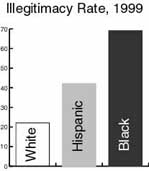 |
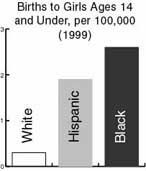 |
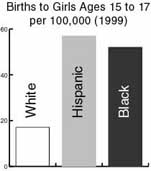 |
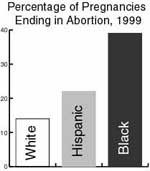 |
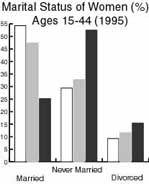 |
 |
 |
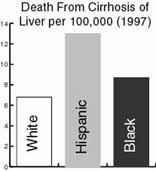 |
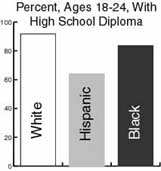 |
 |
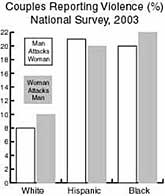 |
 |
 |
 |
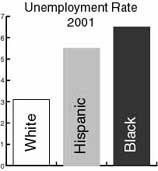 |
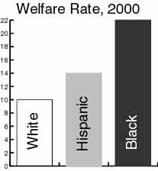 |
 |
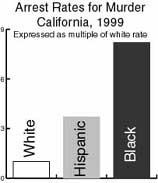 |
To praise Hispanic “family values” is to imply that the social and moral character of Hispanics is superior to that of other Americans. Presumably this means Hispanics are particularly likely to marry, have children within wedlock, support their families, care for their children, and set a good example for them. In fact, none of this is true. By virtually every significant social measure, Hispanics rank below whites and even, on occasion, below blacks. Strong Hispanic “family values” are a myth.
Probably the single best indicator of the strength of “family values” in any community is the illegitimacy rate. As the graph to the left shows, fully 42 percent of Hispanic women who gave birth in 1999 were unmarried. The black rate of 69 percent was even worse, and the white rate of 22 percent is hardly admirable, but Hispanics were still nearly twice as likely as whites to have illegitimate children.
Many of these children are the result of pregnancy at a very early age. As the graph to the right shows, Hispanic girls under age 14 give birth at a rate more than four times the white rate. Child-bearing as young as this is nearly always a prelude to disaster. When it comes to births to girl ages 15 to 17, Hispanics, at three times the white rate, are even more fertile than blacks (left). This country has put a huge effort into persuading teenagers not to have children; Hispanics are not listening. Moreover, Hispanic teenagers are not giving birth because they are Catholic and avoid abortion for religious reasons. As the graph to the right shows, Hispanics are 57 percent more likely than whites to abort. Yet Republicans somehow persist in believing Hispanics are a naturally “pro-life” constituency that will respond to conservative appeals.
Hispanics do marry, and are considerably more likely to do so than blacks, but are less likely than whites. As the graph to the left shows, they are also more likely than whites to be divorced, and never to have married.
Are Hispanics good parents? One minimal measure of success is keeping one’s children from being killed. As the graph to the right indicates, Hispanic children, ages 10 to 19, are four times more likely than whites to be shot to death. The figures in this graph are for California rather than for the country as a whole, but California is the state with the largest number of Hispanics — 11 million, or 32.4 percent of the national total — and there is no reason to think it unrepresentative. As the graph below shows, Hispanics are more likely than whites to abuse their children, though they do so less often than blacks or American Indians.
Hispanics are also bad parents when it comes to automobile safety. A study of Colorado traffic accidents published in the December 2000 issue of the Annals of Emergency Medicine concludes that, compared to whites, “Hispanic drivers have higher rates of safety belt nonuse, speeding, invalid licensure and alcohol involvement, with correspondingly higher rates of death in traffic crashes.” How much higher? A University of Colorado study found that the death rate in accidents was 75 percent higher for Hispanics than whites. For children the figures are almost as bad. A study in 1998 by Johns Hopkins University found that Hispanic children are 72 percent more likely to die in traffic accidents than white children. Hispanics are equally irresponsible after an accident. As the Atlanta Journal-Constitution has noted, they are “more likely to run after a crash,” partly because many are here illegally and do not have insurance. Uninsured drivers raise the cost of insurance for everyone else.
Hispanics are also more likely than whites to drive drunk. A University of Texas study published in 2002 found that 19 percent of Hispanic men reported having been arrested for drunk driving, compared to 13 percent for white men. Is this because Hispanics simply drink more? This is suggested by death rates from cirrhosis of the liver (right), a condition usually brought on by chronic drunkenness. Nor is Hispanic alcoholism restricted to men. The Fetal Alcohol Syndrome Surveillance Network reports that in Arizona and Colorado — two heavily Hispanic states probably typical of the nation as a whole — Hispanic babies are twice as likely as white babies to be born with fetal alcohol syndrome, which leaves them disfigured and mentally retarded. There is only one way for a mother to give her child FAS: stay drunk for most of her pregnancy. Many people think irresponsibility at this level should be a crime, and some legislators have tried to pass laws to jail and forcibly dry out alcoholic mothers.
An important duty of parents is to see that their children are educated. Hispanics are even less likely than blacks to finish high school, which reflects as much on parents as on students (left). Those who do graduate have test scores far below those of whites, and only a few points higher than blacks. The billions America has poured into bilingual education and other programs to boost Hispanic performance and keep them in school are not working.
Hispanics do a poor job of providing medical care for their children. As the graph to the right shows, more than a third — a proportion even greater than for blacks — do not have medical insurance.
Hispanic couples do not treat each other any better than they treat their children. They attack their spouses — legal or common law — twice as often as whites do, and at about the same rate as blacks (left). As has now been well established, women generally attack men slightly more often than the reverse — but not Hispanics. Here, perhaps the myth of machismo lives on, with Hispanic men slightly more likely to beat their women than the other way around.
Rates of sexually transmitted diseases are a good indicator both of promiscuity and indifference to hygiene. Rates for Hispanics for syphilis, gonorrhea, and HIV infection are considerably lower than for blacks, but are about three times the white rate (below).
Most people expect parents to work hard to support their children, and we hear over and over that Hispanics are ready to take any job, even jobs native whites refuse. Why, then, are they more likely than whites to be unemployed? Eager-to-work Hispanics pouring across the border should have virtually no unemployment, yet their jobless rate is nearly double that of whites (right). And why are Hispanics more likely than whites to be on welfare (left) if they are willing to take virtually any job?
Although refraining from criminal violence is not usually considered a family value, it should be. It is hard to be a good parent from inside a jail, and a criminal record is not a good example for children. There are no national crime figures that separate Hispanics from whites, but once again California gives an indication of what is likely to be true for Hispanics generally. In California, Hispanics are nearly three times as likely as whites to be murdered, and about four times as likely to be shot to death (left). They are also about 3.7 times more likely than whites to be arrested for murder (right). Those who assume arrest rates reflect nothing but police “racism” should note that in California, Hispanics are actually slightly more likely than whites to be convicted of murder (77.7 percent v. 75.6 percent) once they are arrested. If there is a “racist” plot to jail Hispanics, it must pervade the justice system top to bottom, including the increasingly Hispanic jury pool. California statistics show that Hispanics are well over twice as likely as whites to be arrested for rape and other sexual offenses.
Family Values?
By virtually no conceivable measure do Hispanics demonstrate strong “family values.” In a few respects even blacks are more family-oriented than Hispanics. Do Hispanics in any way deserve the reputation everyone from George Bush on down seems willing to give them? Perhaps in one. Hispanics have the highest lifetime fertility rates of any ethnic group in America, with 3.2 children per woman as opposed to 2.2 for blacks and 1.9 for whites. This means Hispanics who are married, keep their children from being shot, do not abuse them, stay out of jail, have medical insurance, wear seat belts, have a job, drive sober, and do not beat each other probably have more children than white parents who do all the things we consider normal. But do big families necessarily reflect “strong family values?” Not if, as often happens, Hispanics are bringing children into poverty.
By every standard measure, therefore, a burgeoning Hispanic population only exacerbates problems that have festered for decades: crime, illegitimacy, teen pregnancy, unemployment, poor school performance, poverty. Even if Hispanics really do take jobs no other Americans will — and their unemployment and welfare rates prove that certainly not all of them do — the habits they bring with them make them a very bad demographic bargain.
Opposition to Mr. Bush’s amnesty plan has mainly been against the idea of rewarding people who have broken the law. This is certainly a good reason to oppose the plan. However, this suggests that if these seven to 12 million Hispanics were here legally rather than illegally we should be pleased to have them.
In matters of immigration, it is essential to ask ourselves which newcomers are good for America and which are not. Decisions about immigration affect the nature of our country for generations to come, a matter far too important to be side-stepped. We must be blunt: Hispanics, on the whole, are not good for America. It is folly to open our country to a population that suffers disproportionately from the very problems we are most desperate to solve.
Hispanic immigration also brings challenges impossible to quantify in standard sociological terms. Hispanics are already creating language enclaves that in the long-term could threaten the country with the kinds of divisions that wrack Belgium and Quebec. At the same time, more than half of all Hispanics are Mexicans, who bring with them a deep loyalty to a foreign country that lies just across our southern border. There is already a vigorous irredentist movement that goes by the name of Movimiento Estudiantil Chicano de Aztlan (MEChA) and has chapters at hundreds of American colleges and high schools. Wherever Hispanics arrive in large numbers they so thoroughly change the feel of a neighborhood that many non-Hispanics, white and black, feel uncomfortable and move away.
If President Bush continues with his plans for amnesty, there will be a national debate about immigration, but it is a debate that will miss the point. The question of legality or illegality is a side issue. The question is whether America should become more Hispanic, and the answer is clearly no.
| ARTICLE |
|---|
Hispanics and the Law
In most parts of the United States, Hispanic criminals are reported in police statistics as “white,” thereby artificially inflating the white crime rate. California, one of the few states that keeps separate statistics on crimes committed by Hispanics, reports that they are more than twice as likely as whites to be arrested for rape and other sex crimes, and about three times more likely to be arrested for violent crimes of all kinds.
There are no publicly-available ethnic breakdowns on sexual offenses against children, but news accounts suggest a predilection among Hispanic predators for very young victims. All but one of the following incidents were never reported outside their local areas, and a thorough search would no doubt uncover others. To be sure, horrible offenders are found in every ethnic group, but the following haphazard collection of assaults — all of them recent — suggests a unusual level of odiousness. Had the perpetrators been white, some of the crimes could well have become national news.
In July 2003, police charged José Alvarado, a Salvadoran illegal, with raping the five-year-old son of a woman who rented him a room in Rockville, Maryland. Mr. Alvarado was deported in 1998 for molesting a 10-year-old boy, but sneaked back into the country to commit a similar crime.
In Denver, Colorado, Erick Salazar-Rivasplata was sentenced on Sept. 12, 2003, to at least 60 years in prison for kidnapping and raping first-grade girls. In the fall of 2000, he abducted and raped a seven-year-old as she walked to school. In January 2001, he committed the same crime with another seven-year-old. Prosecutors said Mr. Salazar-Rivasplata “planned, watched and waited” for his victims.
In 2001, Salomé “Sal” Gonzalez was convicted of raping a nine-year-old girl and photographing his crimes. In March 2003, while he was in prison, officials found evidence that he raped and killed an eight-year-old in Pontiac, Michigan, in 1995. He had raped her on numerous occasions, and when she threatened to report him he shot her in the back yard of her home.
In May 2003, Oregon police arrested Tania Sonia Perez, 31, for letting two Hispanic men have sex with her 11-year-old daughter. Miss Perez’s activities came to the attention of authorities when county juvenile officials discovered her daughter was pregnant. The girl turned 12 before giving birth to a baby girl in August.
In September 2003, Miami police arrested Elias Rapalo, 32, a Honduran immigrant in the United States on an expired visa. His DNA matched forensic samples from a series of seven rapes of victims ranging in age from 11 to 79.
On Jan. 28, 2004, the Justice Department announced the indictment of three Mexican brothers on charges of smuggling young girls into the United States and forcing them into prostitution in the Atlanta area. Juan Reyes Rojas, José Reyes Rojas and Raul Reyes Rojas promised the girls jobs, marched them across the border, and forced them to have sex with many men every day.
On May 19, 2002, eight Hispanics brutally gang-raped a girl in a Madera County, California, vineyard. The victim was 12 years old.
In March 2003, Raul Cortez-Herrera and Gabriel Hernandez were charged with rape in Montesano, Washington. Their victim was also 12 years old.
On New Year’s Day 2003, four members of a Hispanic street gang kidnapped a 16-year-old girl in Des Moines, Iowa, and drove her around for three hours while they took turns raping her. The men stopped for refreshments at a convenience store, and police were able to identify Juan Murillo, 22, from the surveillance video.
Of these crimes, the only one to get any publicity was that of Waldina Flores, a woman who molested the daughter of a Florida family who employed her as a nanny. Miss Flores admitted in a Fort Lauderdale courtroom that she began molesting Lauren Book when the girl was 12, and continued doing so until she was 16. The girl’s father, Ron Book, said the 35-year-old Miss Flores “brainwashed” his daughter. On Oct. 10, 2002, Miss Flores was given a 15-year sentence but continued in prison to write Lauren letters that her father called “disgusting and despicable.” This story became known only because Mr. Book was an influential Florida lobbyist.
Miguel Loza is accused of slashing a 17-year-old California girl’s throat and then raping her friend. The 17-year-old died six months after the February 2003 attack, never regaining consciousness. Mr. Loza faces charges of homicide, sodomy, assault with a deadly weapon and forcible sex assault on a child, but prosecutors in Santa Cruz County cannot bring him to trial. Mr. Loza fled across the border and is behind bars in Mexico City, but officials there refuse to extradite him.
For years, Mexico has refused extradition of citizens who may face the death penalty, and US prosecutors have sometimes managed to get their hands on Mexicans by promising a maximum penalty of life without possibility of parole. In October 2001, the Mexican supreme court ruled that life without parole violates the Mexican constitution. As the San Francisco Chronicle explains, “Extradition is now routinely denied in more that 40 categories of serious crime that are punishable by possible life terms under California [and other state] law.”
This policy has made Mexico a haven for murderers. A Los Angeles prosecutor has compiled a list of 246 suspects — most of them accused murderers — known to have fled to Mexico, and this is only the number wanted in California.
Mexican courts sometimes prosecute fugitive criminals, but are often lenient toward those who kill in the United States. In one case, a man wanted for murder in Los Angeles was sentenced by a Mexican court to eight years in prison, but on appeal, got only weekend jail time. He soon returned to Los Angeles, where a prosecutor explained he could do nothing because of the US Constitution’s prohibition against double jeopardy.
Taylor Scott is the pen name of a Washington journalist.
| ARTICLE |
|---|
Fruits of an Unfettered Mind
The philosophy of conservatism.
John V. Day, Editor, The Lost Philosopher: The Best of Anthony Ludovici, Educational Translation and Scholarship Foundation, 2003, 305 pp., $30.00.
Is racial consciousness always part of a conservative view of the world, or is it compatible with what is known as liberalism? At the present time, when consciousness of race is rare among whites, it is usually associated with conservative thinking. Some have pointed out, however, that this was not always so: that for centuries, racial consciousness was part of the common heritage of whites, uniting men who were otherwise antagonists.
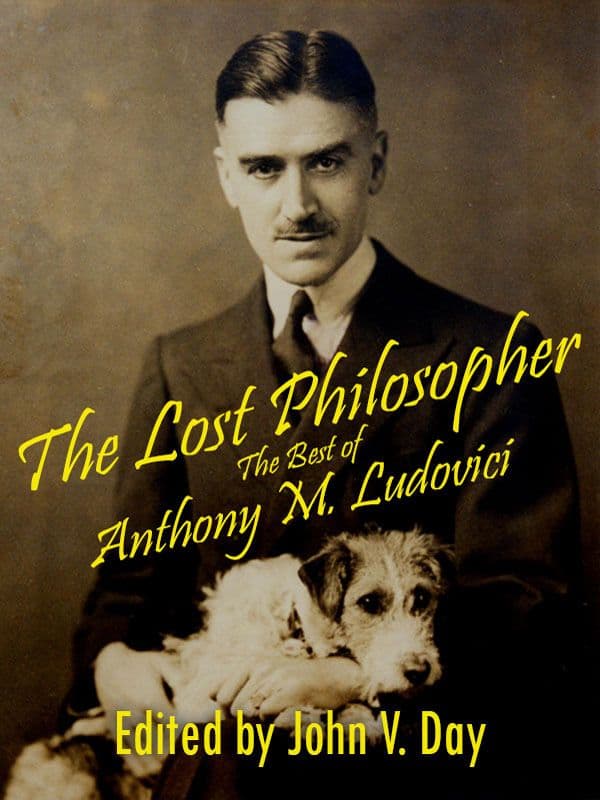
The now-forgotten British author Anthony Ludovici (1882–1971), reintroduced in this new collection edited by John Day, would have argued that racial awareness is inherently conservative. He was a novelist, critic, and essayist who, in the 1920s and ‘30s, was one of Britain’s most prominent writers. This is a volume of selections from his many books, and includes passages from A Defense of Aristocracy, Woman: A Vindication, The Night-Hoers, The Choice of a Mate, Religion for Infidels, A Defense of Conservatism, and Man: An Indictment. A considerable collection of his work is available on the Internet at anthonymludovici.com.
Ludovici wrote on a variety of subjects, but some of his favorites were conservatism, eugenics, women, aristocracy, and religion. He was frankly elitist in a way that would get him drummed out of polite society today, and in his own time never trimmed his opinions to advance his career. He did not write mainly or even at particular length about race; he simply took it for granted in an age in which it was common to do so. A conviction of the importance of race, heredity, and national character colored his approach to all questions. His views, therefore, are one indication of the turn of mind a thoughtful man fully conscious of race may take.
Ludovici thought deeply about what a nation required in order to prosper, what sort of men should lead it, and how they should approach their work. He was convinced there could not be progress or happiness without stability. “Conservatism,” he wrote, “is of enormous value, because it is only in a stable environment that the slow work of heredity can build up family qualities, group virtues, national character and racial characteristics.”
In his view, the goal of a politician should be to increase his nation’s prestige, power, and health, but also to “preserve the identity of his nation throughout change,” and to “preserve the national character.” Preservation meant a deep skepticism of faddish uplift programs, and sudden innovations of all kinds. Of the responsible politician, he wrote:
[H]e knows enough about the character and potentialities of his people, and about the eternal characteristics of healthy mankind in general to be able to judge whether new tendencies are possible or fantastic (i.e., whether they are in keeping with the eternal nature of men, or the particular character of his nation, or whether they apply only to angels, goblins, fairies or other romantic fictions, who alone seem to suit the exigencies of hundreds of modern hare-brained schemes).
Ludovici emphasized “the eternal nature of men” because misreadings of human nature lead to disaster:
[A]bove all, the true conservative entertains no high-falutin’ notions about the alleged radical goodness of human nature. All his political schemes, whether they deal with home or foreign relations, are always therefore conceived on the assumption that guile, egotism, acquisitiveness, venality, lust of power, abuse of power and duplicity are likely to be manifested by the groups of humanity concerned, and consequently he is not prone to imagine utopias or ideal states . . .
Politicians must respect both “eternal human nature” and distinctive national character. Ideas and institutions that suit some countries do not suit all. This is, of course, completely at odds with the modern view (fortunately now under attack) that behavior can be infinitely molded and that “democracy” and “women’s rights,” and MTV are the happy ending for all mankind.
So concerned was Ludovici about maintaining national character, that he believed only deep-dyed Englishmen should ever make laws for the English. The thoughtful man, he wrote:
. . . believes in the advisability of having as politicians not only men who can lay some valid claim to a knowledge of humanity, but also men who belong to the stock of those whose policy they are called upon to direct. He also disbelieves, therefore, in having Jews or men of foreign extraction or odd people — that is to say, eccentrics, cranks and fanatics — as politicians in an English Parliament.
Ludovici promoted homogeneity: “Because he believes in character, health, good taste and pure stock, the conservative must always be opposed to miscegenation and the flooding of his country with foreigners.”
Liberals, by contrast, are always trying new, silly schemes that harm the country. Liberalism, he wrote aphoristically, is “the uncritical misunderstanding of all change as progress.” He also was convinced that “it is part of the superstition and short-sightedness of liberalism to suppose that a continual stream of new laws and an incessant remodeling or demolition of institutions can restore a nation’s health and happiness.” This describes very well the American political fashion for “new ideas” and “social programs,” as if it were impossible for a country to get its laws and institutions right and then leave them alone. As Ludovici explains, “only a handful in every generation can bring about change which is elevating.” Most change is degeneration.
This frenzy for change, explained Ludovici, comes from democracy: “Give the millions freedom to influence the nation’s destiny and you must expect individuals to see advantage in a change which is advantageous only to themselves and their like. Their private interests will take precedence of national interests.”
Most of this narrow agitating takes the form of appeals to equality, a concept Ludovici found repulsive and dangerous: “It must . . . be the undesirable, the unskillful, the incompetent, the ugly, the ungifted, in all walks of life, the incapable of all classes, who want equality,” because the wealthy and talented can be brought down and persecuted but ordinary men cannot be made extraordinary. The more heterogeneous a society, the more differences in ability and achievement there will be, and the less favored will have even more reasons to agitate for leveling.
Putting decision-making power in the hands of the people at large must fail because “it is notorious that everywhere on earth the wise, intelligent and discriminating members of the community always constitute the minority.” The ballot is therefore a disastrous way to choose leaders:
“The person selected by mediocrities to represent them must therefore be a man capable of appealing to such people — that is to say, a creature entirely devoid of genius either for ruling or for any other function. As a matter of fact, all he need possess is a third-rate actor’s gift for haranguing his electors about matters they can easily grasp, in language calculated to stimulate their emotions, and he must be guaranteed to hold or to express no original or exceptionally intelligent views.”
Ludovici believed aristocracy was the best form of government: “Aristocracy means essentially power of the best — power of the best for good, because the true aristocrat can achieve permanence for his order and his inferiors only by being a power for good.” He added, however, that it was fatal for aristocracies to be closed or strictly hereditary, and that enlightened aristocrats must always be looking “for men of honor, taste and proper ideas and draw them into the aristocracy.”
Ludovici was not optimistic that aristocracy could be restored: “[T]he people of these [Teutonic and Anglo-Saxon] races will require to see their civilization in ruins about them, as a result of their experiment with democracy, before they will be prepared to alter their opinion of the subject of democratic institutions and agree to label them ‘Poison’ for all time.”
Women
John Day, who edited this collection, writes that differences between the sexes were one of Ludovici’s favorite subjects, and The Lost Philosopher contains long passages about women. Like virtually all men who recognize individual and racial differences, Ludovici believed men and women have different roles, but warned that the highest calling of women did not get nearly enough recognition: “[T]he housewife among the poor who rears a family and discharges all her household duties as well is a heroine,” although in a society that increasingly admired only money, “it was inevitable that unremunerated duties, like those of domesticity and motherhood, should be bereft of dignity.”
Ludovici thought that the care and devotion of a mother were essential to setting a man on the course of greatness: “Anything else that . . . [a woman] may do must be always second best to this, and those who, by misrepresentation and appeals to vanity, persuade her while she is yet quite young that there are callings better than, or at least as good as, motherhood for her are enemies not only of woman, but also of the species.”
A certain amount of patronizing is to be expected from conservatives of previous generations, but Ludovici tends to take an insight about sex differences and exaggerate it to the point of misogyny. He believed, for example, that women naturally pity and look after the weak because an inclination to care for the helpless is a requirement for those who deal with babies, and that this leads to an “attitude of irrational tenderness to cripples and the physiologically botched.” He thought many women were liberals because of what people now call their “nurturing” nature — something that is probably true — but went rather far when he concluded that “this blind instinct necessarily involves a deep-seated and incorrigible lack of taste.” Women, in other words, cannot tell a permanent leech from someone who will improve with help and care. Ludovici also wrote of the female “love of petty power,” which feasts on the helplessness of infants and makes mothers prefer babies to grown-up children.
Ludovici thought that for a woman, emotions are so strong they commonly interfere with rational thought:
Her convictions are so intimately and unconsciously interwoven with her deepest interests and long-cherished beliefs that if, to accept a certain truth, these convictions have to be outraged, she prefers to reject that truth as unacceptable. In this sense, woman’s thinking is largely feeling and her thoughts are largely sensations. The more emphatic and stubborn a woman is in any belief, the more strongly you may suspect that she has not facts but emotional reasons for holding it. That is why women are so notoriously bad at giving reasons for their opinions . . .
Women, Ludovici believed, were not fit for positions of power because a woman does not value men for ability or character but for how they treat her. “This is a comparatively harmless trait,” he wrote, “so long as woman has no power; the moment, however, that she is placed in a position of wielding power, her errors of judgment affect public life, and she only accepts those men as her ministers, advisers or directors who can prostrate themselves with the best grace at her feet, and appeal most irresistibly to her vanity.”
Ludovici also wrote that women see other women as competitors and have a natural loathing and contempt for them. He advises men that if they want to cure a defect in a wife or daughter, they need only point out the same defect in some other woman whom she knows and dislikes.
Ludovici thought women evaluate potential husbands far too narrowly:
Woman, like the female butterfly, the female housefly or the female horsefly, has the very vital and useful instinct to deposit her eggs only where there is a sound promise of food, and ample quantities of it . . . It is not the best-looking repository, or the most refined, or the most learned, or the most artistic, that is sought, but the repository which promises the richest food-supply for the coming brood.
“[T]he man who kills most female hearts,” he added, “is he who can throw a rich fur around his capture and whirl her off in a sumptuous Rolls-Royce. This to the normal decent woman is simply irresistible.”
The habit of evaluating men by their income is life-long: “Thus wives who have passionately loved their husbands will learn to dislike and despise them intensely if owing to some unhappy turn in their fortunes they become material failures. Daughters will also manifest a pronounced dislike towards fathers who, for their station in life, have been inadequate material successes.”
Ludovici wrote that this female preoccupation with materialism spreads to the whole society as women gain power: “It is indeed one of the most pernicious results of woman’s ascendancy in any society that this vulgar pursuit of mere material success (because it provides the surest provision for the offspring) tends to become general . . .” He complains elsewhere of “the stampede for wealth and success in modern, women-ridden society.”
Not surprisingly, Ludovici believed all women should, at all ages, be under the guidance of a man.
Eugenics
Like many men of his time, Ludovici understood that traits are hereditary, and he wrote very forcefully about the folly of welfare: “Every sixpence paid by a desirable couple in taxation and rates for the upkeep of human rubbish is a sacrifice of the greater to the less, and if such a desirable couple curtail their family to meet national expenditure for degenerates, we plainly kill the best to save the worst.” He would not only have encouraged the best to reproduce but wrote that “we must boldly rid ourselves of the feminine and morbid sentimentality” that keeps us from “purging our society of its human foulness.”
He was bitterly opposed to contraception because only superior people who think ahead will use it, and will thus deprive the nation of superior children. “[T]he sale or handling on of contraceptives to desirable and sound couples might be as severely punished as at the present day we punish attempts at poisoning,” he wrote, and urged that “contraceptives . . . be sold as some poisons are now, only on a doctor’s prescription.”
“Marriage between all defectives and degenerates should be forbidden by law,” he argued, and “all acute cases of malformation, degenerative stigmata, crippledom, abnormality should be unhesitatingly done away with . . .” He could not understand people who insist on a dog with a pedigree but do not care about human pedigrees. He thought it only natural to seek to marry someone very like oneself, and “from the mating standpoint,” he wrote, the attitude of an Englishman or -woman should be: “You may be sound and all right as a Negro or a Chinaman, but to me you are repulsive and therefore to be rejected.”
Like so many advocates of eugenics, Ludovici had no children, but on his death in 1971, he left “70,000 pounds to the University of Edinburgh for the study of the effects of miscegenation, especially between blacks and whites. The university declined the bequest.
Out of Step
There was one respect in which Ludovici was out of step with what we generally consider conservatism today: He was passionately anti-Christian. He thought the New Testament’s interest in tavern-keepers, prostitutes, the weak, and the sick was implicit encouragement for dysgenics. He also disliked the universal nature of Christianity, and admired the ethnic exclusiveness of Judaism.
Ludovici also found some of the commandments unrealistic: “No command can make one love anyone who is not lovable. ‘Seek neighbours that are lovable so that you may inevitably love them’ would have been more sensible. ‘Love one another’ is shallow and reveals a poor, almost benighted grasp of human psychology.”
He also thought Christianity, as it was practiced by Europeans, was a cold-weather religion. “The sun is pagan,” he wrote:
In short, it urges man and woman to a wanton enjoyment of life and their fellows; it recalls to them their relationship to the beasts of the field and the birds in the trees: it fills them with a careless thirst and hunger for the chief pastimes of these animals — feeding, drinking and procreation; and the more ‘exalted’ practices of self-abnegation, self-sacrifice and the mortification of the flesh are easily forgotten in such a mood.
Ludovici could not accept Christianity but he recognized the stabilizing role of religion. He thought religion was good for people, but that Christianity was a bad choice.
Ludovici’s view of Christianity may have been influenced by Nietzsche, whom he admired. He agreed with Nietzsche in his conviction that men naturally seek power and dominance, writing of “those numbskulls who begin to see and think of the will to power only when figures like Napoleon, Stalin, or Hitler appear, and who overlook it wholly in themselves, their wives, their children, and their cat . . .”
He believed this meant there could never be utopia — conflict is written into human nature: “What possible trace of realism remains in Shaw’s attribution of all wickedness to poverty, or in Marx’s implication that what men call ‘evil’ will disappear when once a classless society is established?”
Ludovici also took a Nietzschean view of the relationship between character and free will:
To the strong there is no such thing as free will, for free will implies an alternative and the strong man has no alternative. His ruling instinct leaves him no alternative, allows him no hesitation or vacillation. Strength of will is the absence of free will . . .
To the strong there is also no such thing as determinism as the determinists understand it. Environment and circumambient conditions determine nothing in the man of strong will. To him the only thing that counts, the only thing he hears, is his inner voice, the voice of his ruling instinct.
Only the weak, who do not have a consistent internal voice, appear to be free because they can act without consistency.
The editor of this collection calls it The Lost Philosopher, but the selections he offers do not justify the title. Ludovici was more an essayist than a philosopher, even if he did develop some of his subjects in detail. What today’s readers are most likely to hold against him, however, is his habit of asserting something — something that may even be true — without any substantiation. He simply asserts, for example, that women are emotional and, consequently, unfit for public office. This is fine for people who already agree with him, but not much use for anyone else.
At the same time, though, there is charm in Ludovici’s straightforwardness, his unwillingness to qualify or explain. Today, anyone who strays the least bit beyond the liberal pale must spend half his book clearing his throat, shuffling his feet, and apologizing for hurt feelings. It was a sign of the good health of the decades in which Ludovici was active that he could write as he did — and no doubt shock a few people in the process — and yet retain a wide readership and high professional standing.
“Biologically, absolute beauty exists only within the confines of a particular race,” he once wrote, adding that anyone who begins to think people of other races are beautiful has begun to cut himself off from his own race. Ludovici offered no data to support this view, cited no authorities, provided no further explanation, and did not apologize to anyone whose feelings he might hurt. We must envy both the man who wrote this and the age in which he wrote it for freedoms that have now all but disappeared.
| ARTICLE |
|---|
The Truth About Tuskegee
Another fake story of white infamy.
The Tuskegee syphilis study ranks almost with slavery and lynching as a symbol of America’s racist past. There is probably not one black American adult who does not know — or thinks he knows — about an experiment from the 1930s in which government health authorities deliberately withheld treatment from 400 black syphilitics just to see what would happen to them. In some versions of story, the government deliberately infected the men. At the very least, the authorities are said to have been guilty of withholding the effective treatments that became available in the 1950s. Blacks often cite fear of “another Tuskegee” to explain why so few of them cooperate with public health programs or donate organs for transplant. They never know when white doctors might experiment on them.
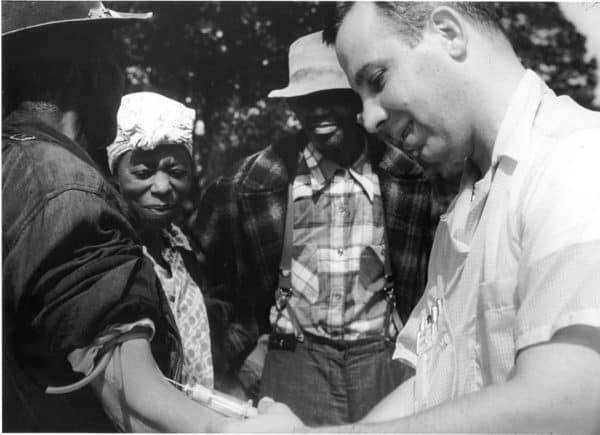
A doctor draws blood from one of the Tuskegee test subjects.
Anthropologist Richard Shweder of the University of Chicago has just published a detailed analysis of the Tuskegee study at spikedonline.com, in which he shows that virtually every popular assumption about the study is false. It was undertaken by “progressives” who wanted to fight a disease that afflicted many blacks, it had the full support of black medical authorities to the end, and — most important — it probably caused no harm to the 140 men (not 400) who took part.
The US Public Health Service started the study in 1932 in Macon County, Alabama, where syphilis rates for blacks ranged between 20 and 36 percent. At the time, there were a number of treatments for the disease but they were complicated, disagreeable, and not very effective. The treatments involved a year-long series of carefully-monitored intravenous injections of an arsenic compound that had such unpleasant side-effects that fully 85 percent of patients dropped out before completing treatment. Of the 15 percent who stuck it out, few were cured. Public health officials knew they needed better drugs, but they also needed a baseline, or control group, to which they could compare the results of treatment. This was why they wanted to know what happens when there is no treatment.
As Prof. Shweder explains, syphilis is not always the raging killer most of us think it is. First of all, it is only in the early stages of the disease, when sores appear on the body, that it is contagious, and this was the only stage at which arsenic had any effect at all. After that, syphilis goes latent, with no symptoms, and the patient is not infectious. Untreated syphilis can then go on to the tertiary stage and destroy vital organs like the heart and brain — this is what happened to famous victims like Al Capone (Nietzsche is widely thought to have died of syphilis but the disease was brain cancer) — but for perhaps 80 percent of syphilitics, the disease stays latent, and it is as though they never had it. The longer it is latent, the longer it is likely to stay that way. It is, in Prof. Shweder’s terms, “self-limiting or self-correcting.”
Today, most public information campaigns do not emphasize this. Health authorities trumpet the potential for devastation rather than tell people they have a good chance of escaping unscathed. The Illinois Department of Health is the exception in explaining that:
If untreated, syphilis then lapses into a latent stage during which the disease is no longer contagious and no symptoms are present. Many people who are not treated will suffer no further consequences of the disease.
It was the latent stage health authorities wanted to investigate in 1932. Consequently, when they examined 410 syphilitic blacks for possible inclusion in the study, they found many were in the early, infectious stage, and rejected them as candidates. They turned over no fewer than 178 for the standard arsenic treatment, and kept 140 for the study. They then checked up on these men at rather lengthy intervals — in 1938, 1948, 1952, and 1963 — giving them full physical examinations, and treating them for any disease other than syphilis. A black nurse named Eunice Rivers ran the program, keeping in close contact with the men to make sure they did not drift out of touch. She was apparently a remarkable woman who created something of a social club around the study.
The outset of the program was therefore entirely unobjectionable. The men had already entered the latent stage of syphilis, for which the standard and largely ineffective cure of the day was no good at all. Foregoing that was no hardship, and in exchange they got free medical checkups and the benefits of Nurse Rivers’s kind attention. The black administration of Booker T. Washington’s Tuskegee Institute blessed the study.
By the mid-1950s, however, penicillin became available as the standard cure for syphilis. Should not the Public Health Service have stopped the study and treated the men? By then, they had been infected for 20 or 25 years. Some number had died of heart disease probably brought on by tertiary syphilis, but for those who were still alive in the 1950s, the disease had very likely run its course. Ninety men were still part of the program at the time of the last examination in 1963, and penicillin treatment, even when it first became available, would probably have done them no good. Prof. Shweder suggests that by then these men may well have had life expectancies as high as other black men of the same age who had never had syphilis at all!
It is possible, of course, to criticize the study on the grounds that its subjects did not give “informed consent.” No one explained the rationale of the study to them, other than to say they had “bad blood” (the euphemism for syphilis at the time), and that their occasional medical examinations had something to do with it. However, as Prof. Shweder points out, the concept of “informed consent” did not exist in 1932, and it was common for doctors to tell their patients — black or white — very little. He goes on to argue that since there was little harm to the men and some benefit, the Public Health Service would probably have had no shortage of subjects even if it had explained every detail at every stage.
Of course, the study finally was stopped in 1972, hardly helped by press coverage like that of the New York Times, which titled its July 26 story of that year, “Syphilis Victims in U.S. Study Went Untreated for 40 Years.” Not even the redoubtable Eunice Rivers was able to fight off the terrible black cloud that descended on the program, and it has gained a permanent place in the lore of American “racism.”
The “Tuskegee Study of Untreated Syphilis in the Negro Male,” as it was officially called, is probably beyond redemption. The standard version of white perfidy probably cannot be displaced any more than the truth about the World War II relocation camps can displace the common conviction that they were “concentration camps” in which Japanese were forcibly interned. Nor is this process of falsifying history in ways that discredit whites over. It is now common “knowledge” that DNA evidence has proven Thomas Jefferson fathered illegitimate children with Sally Hemings, even though it has done no such thing. So many whites so badly want to hear the worst about themselves they can hardly let the truth spoil a good yarn about “racism.”
| IN THE NEWS |
|---|
O Tempora, O Mores!
Miserable Haiti
Haiti is one of the most unhappy places on earth. It has the third highest rate of malnutrition in the world, and is on par with sub-Saharan Africa in life expectancy and availability of clean water. A greater percentage of its citizens live in poverty than those of war-ravaged Congo. It has the highest AIDS rate in the Western hemisphere. Perhaps worst of all, Haitians have destroyed their primary natural resource: land.

Once known as the “Pearl of the Antilles,” Haiti was covered with thick timber and rich soil. In the last 50 years, as the population quadrupled, Haitians cut down 99 percent of the country’s tree cover, and erosion has destroyed two-thirds of its farmland. The eight million Haitians survive on foreign aid, and think America is the promised land. The Haitian population in Florida has doubled in the past decade to about half a million. Many keep in contact with their homeland and encourage yet more immigrants. [Tim Collie, Haiti: ‘The world doesn’t have any idea how bad this is getting,’ South Florida Sun-Sentinel, Dec. 7, 2003.]
In 1994, the Clinton administration backed the “Operation Restore Freedom,” invasion of Haiti, an ironic choice of name, since Haiti has never experienced freedom. The United States restored Jean-Bertrand Aristide, a Marxist former priest, to power, and the administration claimed a great triumph for democracy. President Aristide has proven no more democratic than his predecessors; he fixes elections and uses gangs to intimidate opponents. He so openly stole the presidential election in 2000 that the US and the European Union canceled foreign aid.
President Aristide blames the failures of his country on the white countries that reinstated him and have given him billions of dollars. At the celebration of the 200th anniversary of Haitian independence, he said, “After 200 years of economic violence, the traces of slavery are still here. Whether it be slavery or embargo, it’s the same plot. You are victims.” By the term “embargo,” he meant the suspension of foreign aid.
The stolen election and the miserable state of the country have caused great unrest. President Aristide’s political thugs are called “chimères” (“monsters”), and come from the worst ghettos — some go by the names of American rappers like “Snoop Dogg” and “Tupac Shakur.” A few of these gangs, however, have turned against the president. One of these is called “the Cannibal Army,” and currently controls the town of Gonaives. As many as 10,000 students at a time have joined in protest against the regime. Clashes among students, “cannibals,” and “monsters” have led to mayhem in Port-au-Prince and throughout the country. Drunken “monsters,” chanting “Aristide for King!” swagger about, steal cars, and fire on people seemingly at random, while students march in the streets with banners bearing the black cross. This is the cross of Baron, voodoo master of the dead and keeper of cemeteries, and symbolizes the students’ readiness to die for their cause. Mr. Aristide’s supporters will be pleased to put this readiness to the test. [Marcus Warren, Monsters and Cannibals at War in Haiti, The Electronic Telegraph, Dec. 13, 2003; Michael Radu, Clinton’s Haitian Nightmare, FrontPageMagazine. com, Jan. 22, 2004.]
New Americans?
The Day of the Dead, during which relatives gather at cemeteries to commemorate the dead, is a national tradition Mexicans celebrate on November 2. People place offerings of flowers, candles, and meals at graves, and put up skeletons bearing the names of both the living and the dead. Because of the importance of this tradition, Mexicans who immigrate to America do not want to be buried here, but in their homeland so that they can be honored by their families. Nearly all illegal immigrants are shipped to Mexico after they die, but even Mexicans who become US citizens generally say they want to be buried in what they consider their real home. More than 1,200 Mexican corpses were sent home from Los Angeles airport alone in 2002, despite the fee of $1,500 that funeral homes charge for shipping a body. According to a Mexican farmer, immigrants to America “don’t want to lose their identity as a Mexican. What they want is to find a way back to be here, even if they come back dead.” [Morgan Lee, Thousands of Bodies Flown Back to Mexico, Miami Herald, Nov. 1, 2003.]
Uppity Whites
In California, students at two high schools have tried, and failed, to found “Caucasian Clubs.” The first is Lisa McClelland of Oakley, who got the idea after seeing there were student groups for blacks, Hispanics, and Asians at her school, but none for whites. She got more than 300 signatures from students and townspeople, most of them non-whites, on a petition to found a “Caucasian Club,” which was to deal with European heritage and “issues of racial disparity.” The club would have allowed non-white members and had planned field trips to museums to study white history.
Miss McClelland has described herself as a “mutt.” “I’m Latina, Mexican, Irish, Scottish, German and Dutch. I’m everything — a true American,” she says, but her campaign proved to be, in her words, “too politically incorrect.” Darrell Turner, an official of the local chapter of the NAACP said he was “vehemently opposed” to it. “When we use the word ‘white’ or ‘Caucasian’ or whatever, it has always been associated with racial bigotry.” No faculty member would sponsor the club, and students intimidated Miss McClelland. “Some people would say words like ‘racist’ when they see me,” she said. “Some people would give me a look. Some people would whisper something.” She also says Hispanic boys threatened to beat her up. She became so uncomfortable she moved to a different school. [Valerie Richardson, Caucasian Club Creates Imbroglio, Washington Times, Sept. 23, 2003; Barbara Simpson, Caucasian a Bigoted Term, WorldNetDaily. com, Sept. 22, 2003; Valerie Richardson, Girl Abandons Caucasian Club Effort, Washington Times, Nov. 24, 2003.]
In Piedmont High School in the San Francisco Bay area, the assistant principal, Randall Booker, approved students’ plan for a “Caucasian Student Union.” However, Mr. Booker canceled the club after one of its members attended a meeting wearing a Confederate flag belt buckle, which, he says, caused a “disruption.” “This was all very precarious,” Mr. Booker says. “Does having a Caucasian Student Union create a hostile environment? No. Does having a Caucasian Student Union with one of its members wearing a Confederate flag belt buckle create a hostile environment? Yes.” [José Antonio Vargas, In World of Racial Diversity, What is ‘White’? San Francisco Chronicle, Dec. 8, 2003.]
Tim Bueler, founder of the Rancho Cotate High School Conservative Club, has suffered greatly for suggesting that the government crack down on illegal immigration. Both students and teachers were disturbed by his Dec. 12article in the club’s newsletter, in which he wrote, “Liberals welcome every Muhammad, Jamul and Jose who wishes to leave his Third World state and come to America.” Hispanic classmates have called him “white boy,” “racist,” and a “marked man,” and threatened to beat him up. At one point, in anticipation of trouble, the school called in 15 police officers. Teachers have joined in, calling Mr. Bueler a “Nazi” and the members of his club “bigots” and “wing-nuts.”
His teachers have not protected him against threats from classmates. Once he escaped a dozen Hispanic boys who threatened him in the hall, by ducking into a classroom, and asking the teacher for help. Mr. Bueler reports that she said, “No. Get out of here.” On another occasion, when he asked for help after some Hispanic students blocked his exit from a classroom, a teacher replied, “When you say things like that, you’ve got to expect that things like this are going to happen. Why don’t you go out the back door?” [Valerie Richardson, A Dissenting Student Hounded for His Views, Washington Times, Dec. 30, 2003; Cecilia M. Vega, Tensions Persist at Rohnert Park School, Jan. 31, 2004.]
Al Sharpton’s presidential campaign has proved notable for its race-huckstering, legal corner-cutting, free spending, and incompetence. While the media have criticized Howard Dean for his frenzied campaign speech after his defeat in Iowa, it was far tamer than Rev. Sharpton’s speeches, which have gotten little attention. In Centersville, South Carolina, he delivered a stump speech in the guise of a sermon from the pulpit of a Baptist church. His message was that blacks should remember their grievances against whites, and vote for him. “A lot of black folk forget where they come from,” but “the struggle is not over.” “You may not be responsible for being down, but you are responsible for getting up.” The congregation chanted “Amen!” after every sentence, and Rev. Sharpton began singing his sermon to the accompaniment of piano and drums. He mocked his opponents’ stiff and unmusical campaign appearances at black churches. “The other candidates wish they had [these churches]. That’s why they’re all running around to them and clapping off-beat.” [Kirsten Sharnberg, Sharpton Resounds in the ‘Amen’ Corner, Chicago Tribune, Feb. 2, 2004.]
The other candidates may not have rhythm, but are better at obeying the law. Mr. Sharpton has been dogged by financial scandals throughout his career, and this campaign has added to them. In a formal complaint against him filed with the Federal Election Commission, the National Legal and Policy Center (NLPC) alleges numerous violations of election law, including a failure to disclose in-kind contributions and expenditures, and acceptance of contributions in excess of legal limits. For example, Rev. Sharpton did not report a lavish fund-raiser sponsored by businessman LaVan Hawkins as a contribution to his campaign, as he is required to do. Since Mr. Hawkins and his wife had already contributed the legal maximum of $2,000 to the campaign, this sponsorship was illegal. Furthermore, Rev. Sharpton reported no contributions from the fund-raiser at all — hardly likely. A business owned by Mr. Hawkins recently paid the candidate a $25,000 “consulting fee.” The NPLC remarks wryly, “While Al Sharpton has been described in many ways, ‘business consultant’ is not the term that typically is used.” Rev. Sharpton claims the records relevant to the complaint were destroyed in a fire. He made the same claim when his finances came under scrutiny in 1997. [National Legal and Policy Center, Sharpton Accused of Running “Off-The-Books” Campaign, Feb. 2, 2004.]
Rev. Sharpton lives lavishly on campaign contributions. He spent $7,343.20 for three nights at the Four Seasons Hotel in Los Angeles, and enjoyed a similarly extravagant stay in Miami — strange priorities for a campaign that has raised only $284,000. [Sharpton’s Hotel Bills Add Up, AP, Jan. 11, 2004.]
Staff incompetence has kept Rev. Sharpton off the ballot for the Louisiana primary. His people did not fill out the forms properly and sent the wrong kind of check. These problems could have been easily corrected if his staff had not waited until a few hours before the deadline to send in the papers. They also listed the wrong telephone number, so it was hard for primary officials to tell Rev. Sharpton’s staff about the problems. [Sharpton Not on Ballot in Louisiana, Shreveport Times, Jan. 31, 2004.]
Rev. Sharpton has not done well in the primaries. His best hope of a win was in Washington, DC, which is 95 percent black. He said he refused to “entertain any notion of coming in second.” Howard Dean won that primary, with 43 percent of the vote; Rev. Sharpton got 34 percent, and Carol Moseley-Braun, 12 percent. A NewsMax article alleges that the candidate’s disappointing finish may be the work of the Democratic establishment, which wants the notorious race-baiter to fail. The unsigned article says Democratic National Committee Chairman Terry McAuliffe persuaded Mrs. Moseley-Braun to run in order to split the black vote and keep Rev. Sharpton from winning. He would certainly have won the DC primary if his votes and Mrs. Moseley-Braun’s had been combined. [Dean Wins First Primary; Sharpton Second, NewsMax, Jan. 14, 2004.]
Tarnished Idols
On Jan. 28, police in Aiken, South Carolina, arrested black septuagenarian soul singer James Brown for domestic violence after he pushed his wife to the floor, brandished a chair over her, and threatened to kill her. If convicted, he faces a $500 fine and 30 days in jail. Mr. Brown is an experienced jailbird, having served two and a half years in a South Carolina prison for a 1988 arrest on drug and assault charges. In May 2003, the governor of the state granted “the godfather of soul” a full pardon.
Mr. Brown grew up in Augusta, Georgia, and owns a radio station there. For years, Augusta had a James Brown Music Festival, but on February 4, in response to public outrage at the news of the arrest, the city changed the name to Garden City Music Festival. “We were not able to find corporate sponsors,” explains arts council Executive Director Brenda Durant, so long as the festival was named after a wife-beater. Mr. Brown’s scheduled performance in the May festival is now in doubt.
Mr. Brown still has something to feel good about. On the same day the arts council renamed the festival, city officials authorized another $10,000 payment on a $40,000 bronze statue of the singer. The city still plans to unveil the monument to kick off the James Brown, err, Garden City Music Festival. [Singer Faces Wife-Abuse Charge, AP, Jan. 29, 2004. Music Festival Drops James Brown’s Name, AP, Feb. 5, 2004.]
On Dec. 30, 2002, the singer Diana Naess, née Ross, formerly of The Supremes, was arrested by Tucson police for driving southbound in northbound traffic. She had a blood-alcohol level of 0.20 percent. Arizona’s legal limit for blood-alcohol while driving is 0.08 percent; anyone who drives at 0.15 percent or higher is guilty of driving under “extreme intoxication.” In June, Mrs. Naess and her lawyer tried to have the blood-alcohol test thrown out on the grounds that police coerced her to take it, but a judge ruled there was no coercion. On February 9, Mrs. Naess pleaded no-contest to driving under intoxication, and the charge of driving under extreme intoxication was dropped. She must serve 48 hours in jail, complete at least 36 hours of treatment for drinking problems, and pay $852 in fines and fees. [Arthur H. Rothstein, Diana Ross Convicted of DUI, AP, Feb. 9, 2004. Joseph Barrios, Ross on the Stand for DUI Charge, Arizona Daily Star, June 24, 2003.]
Bad News for Vultures
More than 70 percent of South Africans buy lottery tickets, including 58 percent of those who earn less than the minimum wage. “The lottery sells fuel for your psychological fantasies about becoming stupendously and fabulously rich,” says South African gambling researcher Peter Collins. Other forms of gambling are also popular. Thirty-two casinos with 20,000 slot machines have opened since the end of white rule, during which gambling was illegal. South Africans as a whole spend 1.9 percent of their incomes on gambling, whereas Americans spend only 0.6 percent. Poor South Africans spend an average of 10 percent of their income.
Gambling is bad news for vultures. Many South Africans believe they arrive at a carcass within a short time of the animal’s death because they are clairvoyant. According to witch-doctors, anyone who drinks a potion made from ground vulture bones can predict winning lottery numbers. “Because of the lottery, a lot more vultures are being killed,” says Terri Wolfe of the Endangered Wildlife Trust of South Africa. [Lottery Draws Throngs of the Poor in South Africa, Los Angeles Times, Dec. 19, 2003.]
The Wages of Ignorance
Every day, Zambian newspapers chronicle the rise of child rape, a crime fueled by the belief that sex with a virgin cures AIDS. Particularly shocking were the rape of a 1½-year-old baby by her father, and the death of an 11-year-old girl after she was repeatedly raped by her half-brother. Four hundred cases of child-rape were recorded in Zambia in 2003, and 238 in 2002. Many believe “traditional healers” (a.k.a, witch-doctors) are to blame for the epidemic because they promote quack cures for AIDS. They also tell their customers that child-rape can boost business profits and help them get promoted. Zambian witch-doctors have an advocacy group, the Traditional Healers of Zambia Association, which denies any wrong-doing. [Shapi Shacinda, Child-Rapes Traced to AIDS-Cure Myth, Reuters, Dec. 19, 2003.]
Sikhing Trouble
Last November, 40,000 Sikhs from all over Europe descended on London to participate in the Guru Nanak procession, the biggest Sikh religious rite held outside India. During a briefing to officers who would be patrolling the streets along the procession’s route, a senior female police inspector advised her men to stay away from food provided by Sikh temples, noting that one officer had eaten temple food and gotten sick. “Their hygiene standards,” she said, “are not as good as ours.”
Sikh leaders were outraged by the inspector’s statement. Ever sensitive to non-white feelings and desperate to recruit more non-white officers, both Scotland Yard and the Metropolitan Police are investigating the incident. Senior police officials, officers from the Sikh Police Association, and representatives from the Sikh community, are running the investigation so justice will no doubt be swift, sure — and impartial. [Hugh Muir, Met Inquries into Alleged Slur on Sikh Temples, Guardian (London), Jan. 2, 2004.]
Don’t Tell the Truth
The number of HIV cases in Glasgow, Scotland, is rising rapidly because of immigration and asylum-seeking from Africa. During 2002-2003 there were 85 new cases in Greater Glasgow, an increase of 77 percent over the previous year, and double the figure for 2001. The Scottish Centre for Infection and Environmental Health describes the majority of new cases as people who got the disease abroad and brought it to Scotland with them. The center likes to give the impression that it is Scots traveling in Africa who become HIV-positive rather than report how many Africans arrive with the disease. “That is information that we have not published because it is felt that is not appropriate. We have to take into account the potential for racism, xenophobia, etc,” explains Prof. David Goldberg, who oversees HIV and AIDS monitoring. Sheila McLean, professor of medical law and ethics at Glasgow University, agrees, adding that the only reason she can think of for knowing the HIV figures would be to encourage prejudice against non-whites. [Tom Curtis, African Immigrants Take Scots HIV/AIDS To Record Levels, The Scotsman (Glasgow) Jan. 28, 2004.]
Brotherly Love
An article in the January 6 Philadelphia Inquirer, “Do You Live a Segregated Life?” elicited the following response from a black reader:
There is nothing wrong with segregation. Most African Americans with good sense want the same social relations that most whites want. We don’t want them living in our neighborhoods. We don’t want our children going to school with theirs. We don’t want our daughters and sons marrying their sons and daughters. No thanks . . . we don’t want or need social integration. We want economic and political integration . . .
If white people are seeking fair relations with African Americans, let them start supporting our businesses . . . Let whites push for more African American judges. Maybe then 80 percent of the people in the jails won’t be African Americans.
We don’t need tea and cookies and fireside chats with white people. We don’t have to pretend we like one another to have good relations. We only need to integrate with the two friends we have in common, Pol and Bill — politics and the almighty dollar.
[Leon A Williams, Blacks Don’t Need Tea and Cookies with Whites, Philadelphia Inquirer, Jan. 13, 2004, p. B2.]
The New Italians
Europeans are trying to come to grips with African immigrants who practice female genital mutilation. Denmark, Sweden and Britain have all passed laws outlawing the procedure. In Italy, Cristiana Scoppa of the Italian Association for Women in Development opposes a similar bill in the Italian parliament because it is “a specific attack against a culture.” A Somali-born gynecologist proposes a compromise.
Dr. Omar Abdulcadir, who practices in Florence, Italy, treats as many as 500 women a year who suffer the consequences of crudely performed mutilations. These include menstrual problems, swelling, and chronic infection. He wants the hospital where he works to let him perform a “largely symbolic” female circumcision, which would involve piercing the tip of the clitoris to draw a drop or two of blood. He thinks this will stop immigrants from taking young girls — under 10 — back to Africa or to unsafe underground local clinics for the traditional procedure. “My proposal isn’t ideal,” he says. “But is there a better answer for how to save the children? Whether they live in Italy or Britain or France or America, they don’t want to let go of their traditions. So I’m trying to give them a way to save that tradition.” [Frank Bruni, Doctor in Italy Tries to Ease Pain of an African Tradition, New York Times, Feb. 1, 2004.]
Campaigning for black votes in South Carolina before the February 3 primary, Democratic presidential candidate and retired army general Wesley Clark attacked front-runner John Kerry for once sounding tepid on affirmative action. When asked why he was criticizing the senator for remarks made more than a decade ago, Gen. Clark said, “because this is not ancient history. This is modern day America. We need affirmative action in this country as long as race is a factor, and it is.”
At black Benedict College, Gen. Clark told the audience he strongly opposed racial profiling, because he was “profiled” by an Arkansas state trooper in 1968 — his hair was long and he was driving a car with foreign license plates. “I had been profiled as one of those long-haired guys who was part of the riots,” he said. “All I was was a captain in the United States Army who hadn’t gotten a haircut in three weeks.” [Beth Fouhy, Clark Needles Kerry on Affirmative Action, AP, Jan. 30, 2004.]
Can an army captain really grow a hippy head of hair in just three weeks?
UNifying Europe
On January 29, UN Secretary General Kofi Annan told the European Parliament to let in more immigrants. Here are some excerpts from his speech:
- “There can be no doubt that European societies need immigrants. Europeans are living longer and having fewer children. Without immigration, the population of the soon-to-be-25 Member States of the EU will drop, from about 450 million now to under 400 million in 2050.”
- “In today’s unequal world, vast numbers of Asians and Africans lack the opportunities for self-improvement that most Europeans take for granted. It is not surprising that many of them see Europe as a land of opportunity, in which they long to begin a new life . . .”
- “. . . Europeans would be unwise to close their doors. That would not only harm their long-term economic and social prospects. It would also drive more and more people to try and come in through the back door . . .”
- “A closed Europe would be a meaner, poorer, weaker, older Europe. An open Europe will be a fairer, richer, stronger, younger Europe . . .”
[Kofi A. Annan, Why Europe Needs an Immigration Strategy, News Release, UN Office of the Secretary General, Jan. 29, 2004.]
Sinofornia
Mass Third-World immigration is rapidly detaching California not only from American but from Western civilization as well. State Assemblyman Leland Y. Lee of San Francisco recently introduced a measure in the state legislature urging the California Building Standards Commission to pass regulations that conform to feng shui, an ancient Chinese form of building design and interior decorating that is supposed to bring health, harmony and prosperity. Feng shui dictates the placement of doors and staircases, the positions of buildings and the alignment of furniture so as increase the flow of chi, or positive energy, and avoid negative energy, or sha. Developers in the San Francisco area conform to feng shui, for example, when they avoid putting houses at T-shaped intersections, which supposedly invite sha. Chinese Californians want this done statewide.
“Feng shui is a very major cultural factor,” says Irene Jhin, publisher of the Chinese New Home Buyer’s Guide. Mr. Yee agrees, saying, “We need to allow the expression of one’s culture. That’s why people come to California.” The true believers may have another, larger agenda. According to a Chinese proverb, the benefits of feng shui can be wide-spread: “If there is harmony in the house, there is order in the nation. If there is order in the nation, there will be peace in the world.” [Patricia Leigh Brown, California Measure Would Align Building Rules With Feng Shui, AP, Jan. 30, 2004.]
Black Child Killers
Last December brought two stories of black men who murdered their white girlfriends’ white children. The first was the gruesome case of Christian Hoerler in Australia, who tortured seven-month-old Jordan Anderson to death in February 2000. Mr. Hoerler hit the child so hard his front teeth went through the roof of his mouth, and crushed his toes with a clamp. He refused to accept full responsibility for the murder because, he claims, the mother asked him to hit the child because he was crying. In December, Mr. Hoerler, who pled guilty to manslaughter, received only an eight-year sentence, to the outrage of the boy’s relatives.
The Australian online news service “news.com.au” originally posted the story, which did not mention race, with photographs of both Mr. Hoerler and his victim. Later, it thought better of this and reposted it without the photographs. [Lorna Knowles, Baby-Killer Gets Eight Years Jail, news.au.com, Dec. 12, 2003.]
In Clinton, Ill., Amanda L. Hamm and Maurice Lagrone, Jr. have been charged with drowning Miss Hamm’s three children, aged 23 months, 3 years, and 6 years. She called the police on September 2 to report that her car had rolled into a lake with the children inside. Police refuse to reveal the motive for the killing. Mr. Lagrone was once convicted of domestic battery. [No Plea from Mother Accused of Drowning Three Children, Washington Times, Dec. 12, 2003.]
Defacing the Desert
In 1937, Congress set aside 330,000 acres along the Arizona-Mexican border as a national treasure, the Organ Pipe Cactus National Monument. The park is home to rare stands of saguaro cacti and fragile ocotillo shrubs. To protect the area further, the National Park Service declared it off-limits to all but hikers in 1978.
Today illegal aliens and drug runners are destroying the fragile ecosystem. Trash is everywhere and vehicle ruts scar the once-pristine sand. Border Patrol agents say they routinely find abandoned cars, fire pits, graffiti, and new desert trails. Rangers consider Organ Pipe the most dangerous park in America. Bandits roam the desert, robbing, raping and murdering illegal aliens. In 2002, a Mexican drug runner wanted for murder south of the border shot and killed 28-year-old park ranger Kris Eggle. The situation is so bad the government is considering erecting a 30-mile steel barricade along the border. [Hugh Dellios, Desert Park Victimized by Illegal Immigration, Knight Ridder News Service, Dec. 19, 2003.]
Out of Their Element
For decades, the Marshall Islands, home of Bikini atoll (the hydrogen bomb test site), were a US protectorate. The islands became independent in 1986, but Marshallese still have the right to emigrate to the United States. They even qualify for federal loans for tuition at American colleges, just like US citizens. More than 10,000 — out of a total population of 60,000 — have moved here, and more are on the way. There aren’t many jobs to keep them at home. The biggest industries are tourism, followed by drying coconut meat and fishing. The unemployment rate is 30 percent.
The biggest problem for Marshallese living in America is adjusting to the Western concept of time, and the faster pace of life. Most Marshallese don’t know how old they are, since they usually only celebrate a child’s first birthday. “Fifty-four,” says islander Conrad Anni when asked his age. “No,” he adds, after thinking it over, “I was born in 1959. Fifty-four.” Wintha Joran, who has lived in the US since 1978, says he remembers how relaxed life was when he told time by the position of the sun. “Here everything is so fast, and you have to be on time for everything,” he says. “The attitude there is you don’t have to worry about anything — everything will be all right.” Mr. Joran still misses being able to catch his dinner by just wading into the shallow water and spearing a fish.
Korab Nemra, a Mashallese living near Seattle since 1986, believes the US is wealthier than the Marshall Islands largely because Americans worry more — about time, work and making money. He says watching the clock and spending time at work away from their families rattles the slow-moving Marshallese. Mr. Nemra has been able to return only three times in 18 years. On each visit, he was reminded how happy the Marshallese were on their islands. “It’s just so mellow there,” he says. “People smile a lot more than here. Sometimes I think, ‘Man, what am I doing here?’” [David Olson, Keeping up With Culture, Not the Clock, Everett (Washington) Herald, Jan. 19, 2004, p.A1.]
Bad Sports
The US Olympic soccer team is playing its qualifying games in Zapopan, Mexico. Prior to a match against Canada on Feb. 5, the Mexican crowd booed during the performance of “Star Spangled Banner”, booed when the American team scored goals, and chanted “Osama! Osama! Osama!” as the US players left the field following their 2-0 victory. [US Soccer Team Hears Osama Chants in Mexico, AP, Feb. 6, 2004.]

| LETTERS FROM READERS |
|---|
Sir — Regarding your article on the differing responses to immigration in Nordic countries, the situation in Finland, which was not mentioned, is surely of interest. Finland has a very small number of immigrants, let in during the last ten years, mainly from Africa. Most are in Helsinki but they are slowly spreading. Finland is now experiencing the same tensions in certain areas that its neighbors became accustomed to decades earlier.
Political opposition to this is essentially based around one man: Tony Halme, a wrestler and former professional boxer, who was elected in 2003 to Finland’s 200-seat parliament as a member of the True Finns Party. Unfortunately his public statements about immigration — such as urging that all black people in Finland be put on a remote island — are ludicrous and ensure that his party will never be supported by anyone but working class voters in Helsinki. Mainstream MPs dismiss him and his party. Finland desperately needs a serious alternative, like the Danish People’s Party, before the country ends up in the same situation as its Nordic neighbors.
Edward Dutton, London, England
Sir — There is a certain grim justice in the non-white transformation of Sweden, given the destructive role Gunnar Myrdal played in American race relations. “Hoist on their own petard,” is what I thought as I read that Swedish cities like Malmo are darkening and descending into crime.
If anything, Swedes may be easier victims of racial-egalitarian nonsense than we are. The US was never a homogeneous society, which is why earlier generations of whites had a healthy racial consciousness. Our history perhaps left us with some anti-bodies the Swedes don’t have. They seem to be even more susceptible to race-denial than we are.
Royce Woodson, Chapel Hill, N.C.
Sir — Although Ian Jobling’s February article about education contains plenty of statistics, anyone looking at the article with a critical eye would notice the complete lack of references or attributions on several contentious statements (e.g., Black pre-schoolers score considerably lower on ability tests than white preschoolers. Black kindergartners are less persistent. Minority parents spend less time reading to children). Either reporting has drifted into speculative editorializing or the author fails to provide source material. (Ironically, the sidebar to the article criticizes other authors for making “baseless claims.”)
I noticed a similar pattern in Dr. Jobling’s previous article on white altruism. While it was a compelling piece, it failed to demonstrate its premise, that whites’ lack of racial self-interest has a genetic cause. Rather, after a review of the self-contradictory concept of competitive altruism, he focuses on phenomena (19th century philanthropists, the rise of the New Left, etc.) that cannot be explained by natural selection, and that suggest the root of the problem is cultural, not biological.
While I find these articles interesting many will find any excuse to dismiss them. It is incumbent upon AR to be rigorous in its reporting if it is to progress beyond “preaching to the choir.”
Brian Byrne, Irvine, Calif.
The style of American Renaissance is journalistic, not scholarly, so we do not ordinarily provide footnotes. The observations about which Mr. Byrne inquires are from Abigail and Stephan Thernstrom’s No Excuses, as should have been clear from the context.
As for competitive altruism, surely it is possible for someone to be more altruistic than someone else, and, if altruism brings high social status, it is not unreasonable to expect that people will want to appear more altruistic. If greater social status brings evolutionary success, as evolutionary psychologists argue, then it is perfectly possible for competitive altruism to evolve.
Sir — Congratulations on your wonderful new website format! Congratulations also on your new book, A Race Against Time, which is a brilliant collection. Your work gives hope to many whites leading quiet lives of desperation, who cannot speak the truth for fear of retribution. I wish I could give you millions. I do send what I can, and will try to do so monthly and encourage others to give as well.
Keep up the good work! You are creating new converts and inspiring whites on the Internet every minute of the day.
Name Withheld
Sir — Several months ago. A British band, Death in June, was scheduled to play at a local club. The band has always used Nazi imagery , but it is not a racist band. The lead singer is openly homosexual. Their lyrics occasionally discuss the glories (and possible downfall) of Western culture, but nothing they have ever said or done attacks any group of people. Death in June promotes no racial messages.
But because of this imagery, two groups in Chicago — the Center for New Community and Anti-Racist Action — protested the performance. They used threats of violence to intimidate the club into canceling the show. On the day of the performance, the band moved to a smaller venue in Chicago. Protesters from the two groups started beating people waiting to see the show. The second venue canceled as well, and Death in June did not play.
Such much for tolerance.
Name withheld, Chicago, Ill.

You must enable Javascript in your browser.















